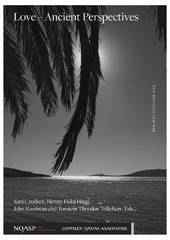Eros and Diastema: The Transformation of Desire in St. Gregory of Nyssa
Аутори
Cvetkovic, Vladimir
Остала ауторства
Grødum, KariHägg, Henny F.
Kaufman, John
Tollefsen, Torstein T.
Поглавље у монографији (Објављена верзија)
Метаподаци
Приказ свих података о документуАпстракт
The paper aims to analyze the relation between the notion of love or desire (eros) for God, and the notion of distance (diastema) between God and the created beings in the works of St Gregory of Nyssa. These two notions are interrelated on different levels, because distance that separates God from the created beings is traversed out of desire for God of the latter. First, the distance as temporal interval will be investigated, which separates the present day from the Second Coming of Christ, which is elaborated by Gregory in his early work On Virginity. The focus will then be shifted to the distance between good and evil, that Gregory explicates in the works of his middle period such as On the making of man, Against Eunomius III and The Great Catechetical Oration. Finally, the distance as an inherent characteristic of created nature that never disappears will be analyzed by focusing on Gregory’s later works, such as Homilies on the Song of Songs, On perfection and The Life of Moses.
Кључне речи:
Gregory of Nyssa / distance / love / desire / period / perfectionИзвор:
Love – Ancient Perspectives, 2021, 101-121Издавач:
- Oslo: Cappelen Damm Akademisk
Финансирање / пројекти:
- Министарство науке, технолошког развоја и иновација Републике Србије, институционално финансирање - 200025 (Универзитет у Београду, Институт за филозофију и друштвену теорију) (RS-MESTD-inst-2020-200025)
Колекције
Институција/група
IFDTTY - CHAP AU - Cvetkovic, Vladimir PY - 2021 UR - http://rifdt.instifdt.bg.ac.rs/123456789/2421 AB - The paper aims to analyze the relation between the notion of love or desire (eros) for God, and the notion of distance (diastema) between God and the created beings in the works of St Gregory of Nyssa. These two notions are interrelated on different levels, because distance that separates God from the created beings is traversed out of desire for God of the latter. First, the distance as temporal interval will be investigated, which separates the present day from the Second Coming of Christ, which is elaborated by Gregory in his early work On Virginity. The focus will then be shifted to the distance between good and evil, that Gregory explicates in the works of his middle period such as On the making of man, Against Eunomius III and The Great Catechetical Oration. Finally, the distance as an inherent characteristic of created nature that never disappears will be analyzed by focusing on Gregory’s later works, such as Homilies on the Song of Songs, On perfection and The Life of Moses. PB - Oslo: Cappelen Damm Akademisk T2 - Love – Ancient Perspectives T1 - Eros and Diastema: The Transformation of Desire in St. Gregory of Nyssa SP - 101 EP - 121 UR - https://hdl.handle.net/21.15107/rcub_rifdt_2421 ER -
@inbook{
author = "Cvetkovic, Vladimir",
year = "2021",
abstract = "The paper aims to analyze the relation between the notion of love or desire (eros) for God, and the notion of distance (diastema) between God and the created beings in the works of St Gregory of Nyssa. These two notions are interrelated on different levels, because distance that separates God from the created beings is traversed out of desire for God of the latter. First, the distance as temporal interval will be investigated, which separates the present day from the Second Coming of Christ, which is elaborated by Gregory in his early work On Virginity. The focus will then be shifted to the distance between good and evil, that Gregory explicates in the works of his middle period such as On the making of man, Against Eunomius III and The Great Catechetical Oration. Finally, the distance as an inherent characteristic of created nature that never disappears will be analyzed by focusing on Gregory’s later works, such as Homilies on the Song of Songs, On perfection and The Life of Moses.",
publisher = "Oslo: Cappelen Damm Akademisk",
journal = "Love – Ancient Perspectives",
booktitle = "Eros and Diastema: The Transformation of Desire in St. Gregory of Nyssa",
pages = "101-121",
url = "https://hdl.handle.net/21.15107/rcub_rifdt_2421"
}
Cvetkovic, V.. (2021). Eros and Diastema: The Transformation of Desire in St. Gregory of Nyssa. in Love – Ancient Perspectives Oslo: Cappelen Damm Akademisk., 101-121. https://hdl.handle.net/21.15107/rcub_rifdt_2421
Cvetkovic V. Eros and Diastema: The Transformation of Desire in St. Gregory of Nyssa. in Love – Ancient Perspectives. 2021;:101-121. https://hdl.handle.net/21.15107/rcub_rifdt_2421 .
Cvetkovic, Vladimir, "Eros and Diastema: The Transformation of Desire in St. Gregory of Nyssa" in Love – Ancient Perspectives (2021):101-121, https://hdl.handle.net/21.15107/rcub_rifdt_2421 .


